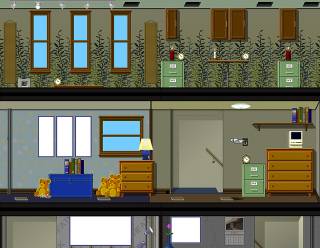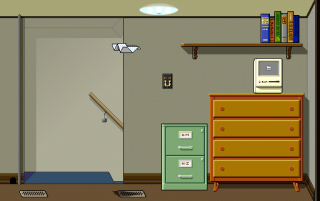Overview
Glider Pro is an orthogonally projected journey of a paper airplane through a common house, to an art museum, castles, outer space, and many other exotic destinations. The player must reach the final level of the world with one to six lives without touching the ground or any objects which would be dangerous to the paper airplane
 Multiple room view introduced in Glider Pro
Multiple room view introduced in Glider ProEarly versions of the game came with one default house which contained 15 rooms to complete, but by the time Glider Pro was released, the room number had increased to 403. In addition to the substantial content, a house editor was included, which extended the community interest in the game by several years, with hundreds of custom houses still available on archive sites. The default house included with the game was co-authored by several community members whom John Calhoun, the game's author, enlisted after seeing their work in earlier versions of the editor.
Gameplay
 Single-room view seen in Glider 4.0
Single-room view seen in Glider 4.0The player controls only the left and right movements of the paper airplane as it travels through rooms as it glides slowly to the ground all the while. Interactive objects in the environment such as air ducts influence the Y-axis movement of the plane to add some degree of difficulty to the gameplay. More advanced room layouts encountered later in the game's multitude of houses include thermostats to manipulate air flow through ventilation ducts in addition to a variety of other dynamic objects that will influence the paper plane's movements. If the paper plane contacts any object in the environment that is not a power-up, including the floor, the plane is immediately destroyed and the room must be redone from the beginning. Players must avoid running into both static and dynamic objects in the environment most of which can be surpassed through trajectory or timing. There are power-ups scattered through rooms to collect to increase score and or give the plane additional abilities such as rubber band projectiles, extra lives, speed boosts, and items which alter the dynamics of the environment. Also included is a local two player mode, where upon one player completing a room, they must wait for the second player to get through before both may proceed.
House-Builder
When a publishing agreement was reached with Casady & Greene following the release of Glider 3.0, a number of requests were placed on Calhoun for additional features. He decided to completely change the method of creating levels by implementing a new editor rather than coding each level individually which was time consuming. The only difficulty was creating a program which would be user-friendly but still allowed for advanced functionality. The editor functions through a tile-based system adding obstacles over a static background image.
Previous Versions
 Glider 3.0
Glider 3.0It is the second commercially licensed game in the franchise and the final version after many earlier released shareware versions throughout development. The first releases of the software were free and mainly for demonstration while Calhoun operated on donations from fans of the game. Sourcecodes for compiling older versions of the game and pre-compiled files can be found on this page.
Glider 1.0 (1988)
The original version released for demonstration.
Glider+ 2.0 (1989)
Features one 15-room house.
Glider+ 3.1.2 (1991)
The last shareware version and the last black and white version, but it was the first to feature sound.
Glider 4.0 (1991)
The first version in 16-bit color, published by Calhoun's new partnership between Casady & Greene and his own company Soft Dorothy. It included an editor for players to create their own house scenarios to share. The transition from black and white dot shading to color was achieved by bi-tonal pattern dithering, creating an even larger range of desaturated colors normally feasible in 16-bit color.
Glider Pro (1994)
The final version was originally released on two 3.5" Floppy Disks, but has now seen additional releases on CD for newer Mac operating systems. With the closure of Casady & Greene in 2003, ownership passed to Calhoun who decided to release the game as freeware on his website. Because this version was made to run on new hardware with larger memory support, Calhoun used 256-bit color rather than pattern dithering.
Log in to comment